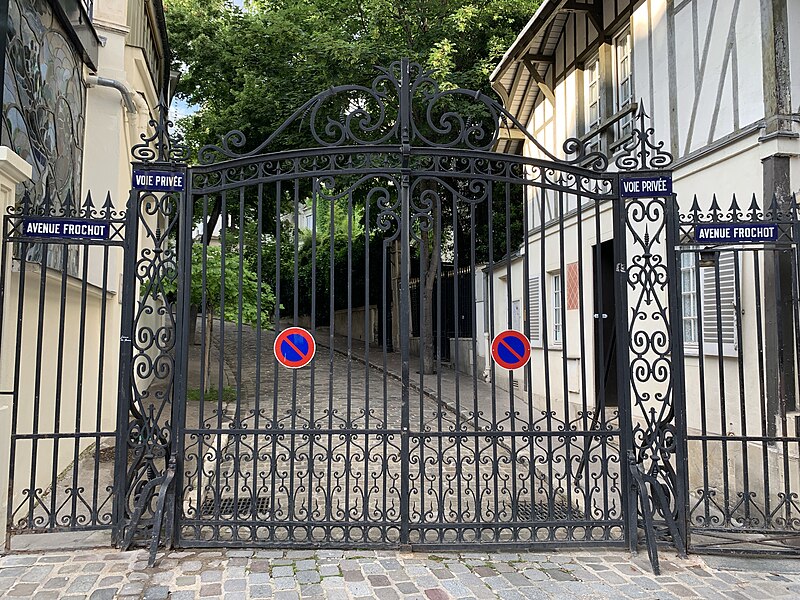Of all the addresses in our city, Paris’ Avenue Frochot is one of the most hidden, and appreciated by those who know it.
But what’s so special about it?
We take a peek behind the private walls and gates, to reveal one of our most secret streets, sure to be of interest to readers of the 56Paris blog.
A sought-after address in the 9th
Paris is a treasure trove of world-famous landmarks, architecture and culture.
But away from the more famous streets, just a stone’s throw from the hubbub of the rue des Martyrs and the place Saint-Georges, you’ll find a place with a little mystique. It’s known as Avenue Frochot.
Nestled in the heart of the 9th arrondissement (district), this private enclave has captivated the imagination of Parisians for nearly two centuries.
Boasting a rich history, beautiful architecture and a prestigious list of former residents, Avenue Frochot offers a unique glimpse into Parisian life, both past and present.
A street steeped in seclusion
The avenue’s story begins in the early 19th century.
In 1826, the prefect of Seine, Count Frochot, commissioned the creation of a new road. Designed to be a peaceful retreat for artists and intellectuals, the avenue was originally built on land that was once the private hunting grounds of King Louis XVI.
Avenue Frochot was always designed to be a secluded haven. Large houses went up behind imposing walls, giving privacy to those living inside.
An iron gate, installed at the southern entrance, further emphasized the exclusivity of the enclave.
Though initially accessible from both the north and south sides, the northern entrance was eventually closed, solidifying Avenue Frochot's status as a self-contained community in Paris.
If you don’t live here, all you can do is look through the hanging wisteria and rose bushes, to get a glimpse of life on this secret street.
The architecture of Paris’ Avenue Frochot
The architecture of Avenue Frochot is a blend of classical and neo-Renaissance styles.
The grand houses that line the street feature elaborate facades, wrought-iron balconies and manicured gardens.
The Haussmannian style, so distinctly Parisian, is also represented along the avenue. These cut stone buildings have mansard roofs and characteristic dormer windows.
The mix of architectural styles on Avenue Frochot is a living timeline of the evolution of Parisian taste over the years. A real melting pot of history, art and of course, architecture.
Home to 19th-century artists and creatives
Many famous names have lived on Avenue Frochot.
Novelist and playwright Paul Meurice called number 5 his home, moving in around 1865. His great friend Victor Hugo sometimes stayed with him.
The renowned French artist Eugène Delacroix, known for his Romantic paintings, resided at number 6 next door.
Writer Alexandre Dumas, author of The Count of Monte Cristo and The Three Musketeers is also a former resident.
Even legendary artist Claude Monet, the founder of Impressionism, had a studio on Avenue Frochot where he worked on some of his famous works.
Other esteemed painters to live here have included Henri de Toulouse-Lautrec, Gustave Moreau, William Haussoulier and Théodore Chassériau.
Celebrities move in…
Over time, the secluded nature of the avenue meant it attracted more than just artists. As the 20th century continued, the avenue remained a magnet for creative minds and celebrities.
Jazz guitarist Django Reinhardt, whose music blended Romani swing with American jazz, called Avenue Frochot home.
International soprano singer Régine Crespin also lived on the avenue for many years, as did 1970s disco star Patrick Hernandez.
Film director Jean Renoir is another famous former resident.
The avenue itself also had a brush with French cinema, immortalized in François Truffaut’s classic film Les Quatre Cents Coups (The 400 Blows), filmed in 1958. It’s now considered one of the greatest movies ever made.
Rumors and urban legends
Away from the artists and celebrities, some say there are other residents of Avenue Frochot… of the ghostly kind!
But the more pragmatic might say that it’s simply the secrecy of the enclave that creates these rumors and legends.
One of the most persistent rumors is that number 1 on the avenue is haunted.
The story goes that, in the 1970s, French singer Sylvie Vartan moved out following a short stay, after experiencing a number of unexplained phenomena.
While the truth of this story is unknown, it certainly adds to the mystique of Avenue Frochot!
Living on Avenue Frochot
Given its secluded nature and prestigious past, it’s no surprise that Avenue Frochot is one of the most sought-after addresses in Paris.
Properties here rarely come up for sale, and when they do, they come with the price tag you’d expect.
The privacy and security offered by the gated community mean life here is a world apart from the hustle of city life. Instead, residents enjoy the lush greenery of the private gardens and architectural beauty.
The avenue’s privacy makes it difficult to catch a glimpse inside. But for those lucky enough to call Avenue Frochot home, it’s a haven of peace and exclusivity in the heart of the City of Lights.
Of course, it’s easier to find properties in the surrounding areas, such as this one-bedroom rental apartment nearby in the 9th.
Finding the right property for you
Do you dream of living the Parisian lifestyle? Perhaps of owning your very own apartment here in the French capital?
Our team of local, English-speaking real estate experts are here to help.
While properties on Paris’ Avenue Frochot might be elusive, we can help you find your perfect apartment in your preferred area of the city.
Please don’t hesitate to get in touch with us today.
You can also follow our social media channels via Facebook, X, Instagram, and Pinterest.
Photos: Chabe01, GFreihalter, Maya-Anaïs Yataghène.
